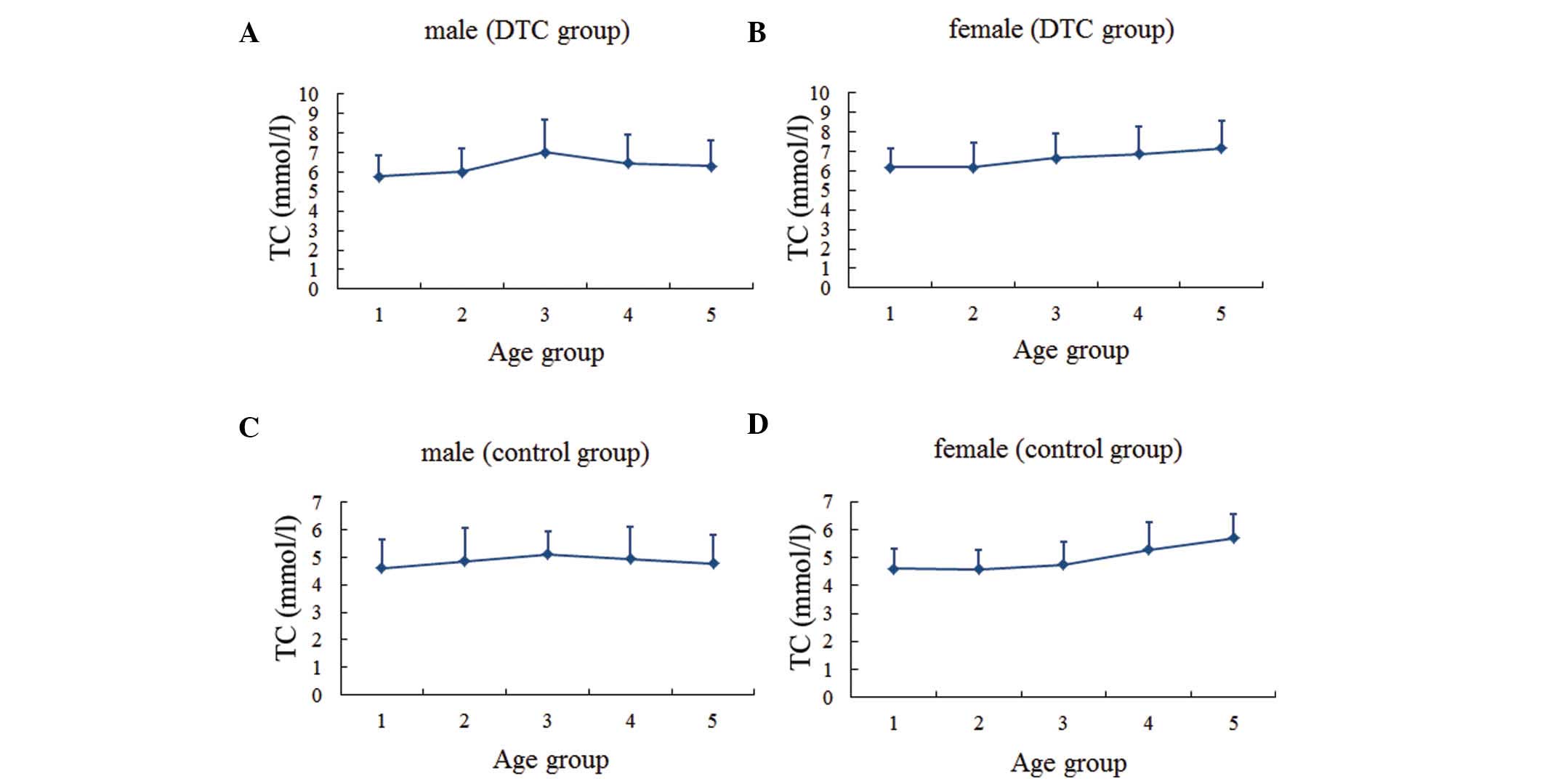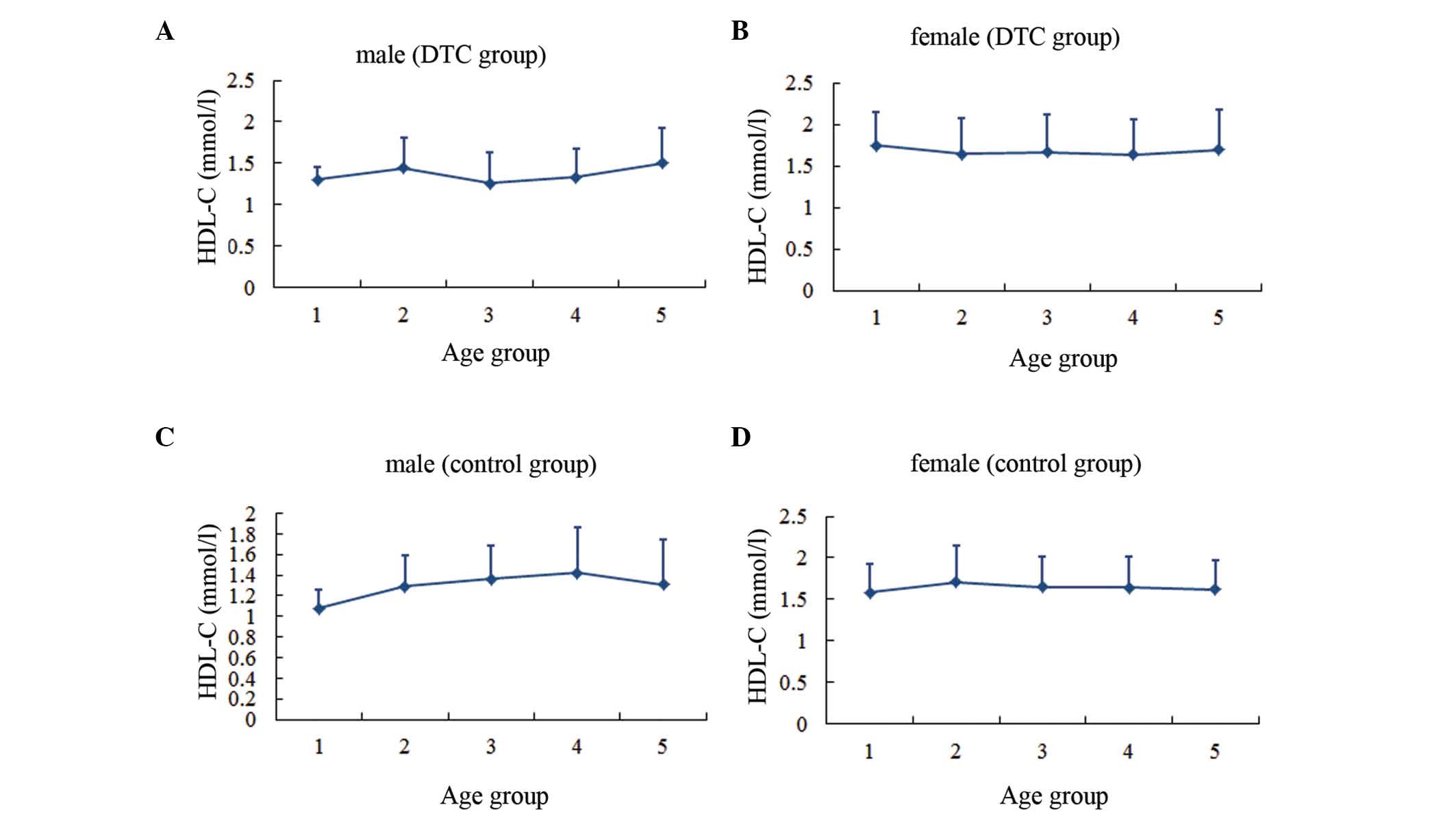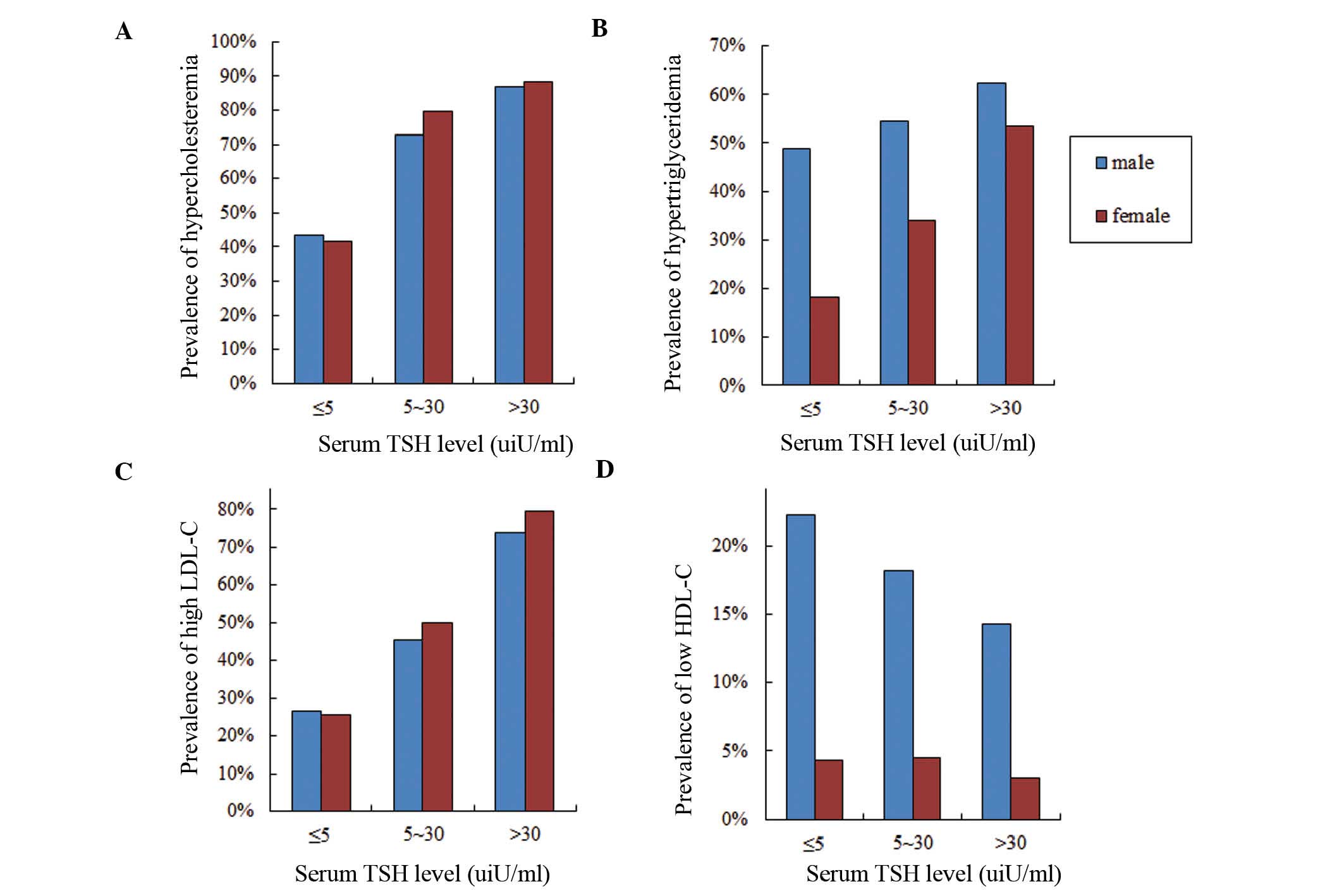|
1
|
American Thyroid Association (ATA)
Guidelines Taskforce on Thyroid Nodules and Differentiated Thyroid
Cancer; Cooper DS, Doherty GM, Haugen BR, Kloos RT, Lee SL, Mandel
SJ, Mazzaferri EL, McIver B, Pacini F, Schlumberger M, et al:
Revised American Thyroid Association management guidelines for
patients with thyroid nodules and differentiated thyroid cancer.
Thyroid. 19:1167–1214. 2009. View Article : Google Scholar : PubMed/NCBI
|
|
2
|
Boone LR, Lagor WR, Mde L Moya, Niesen MI,
Rothblat GH and Ness GC: Thyroid hormone enhances the ability of
serum to accept cellular cholesterol via the ABCA1 transporter.
Atherosclerosis. 218:77–82. 2011. View Article : Google Scholar : PubMed/NCBI
|
|
3
|
Ness GC, Pendleton LC, Li YC and Chiang
JY: Effect of thyroid hormone on hepatic cholesterol 7 alpha
hydroxylase, LDL receptor, HMG-CoA reductase, farnesyl
pyrophosphate synthetase and apolipoprotein A-I mRNA levels in
hypophysectomized rats. Biochem Biophys Res Commun. 172:1150–1156.
1990. View Article : Google Scholar : PubMed/NCBI
|
|
4
|
Walsh JP, Bremner AP, Bulsara MK, O'leary
P, Leedman PJ, Feddema P and Michelangeli V: Thyroid dysfunction
and serum lipids: A community-based study. Clin Endocrinol (Oxf).
63:670–675. 2005. View Article : Google Scholar : PubMed/NCBI
|
|
5
|
Bauer DC, Ettinger B and Browner WS:
Thyroid functions and serum lipids in older women: A
population-based study. Am J Med. 104:546–551. 1998. View Article : Google Scholar : PubMed/NCBI
|
|
6
|
Chubb SA, Davis WA and Davis TM:
Interactions among thyroid function, insulin sensitivity and serum
lipid concentrations: The Fremantle diabetes study. J Clin
Endocrinol Metab. 90:5317–5320. 2005. View Article : Google Scholar : PubMed/NCBI
|
|
7
|
Wang F, Tan Y, Wang C, Zhang X, Zhao Y,
Song X, Zhang B, Guan Q, Xu J, Zhang J, et al: Thyroid-stimulating
hormone levels within the reference range are associated with serum
lipid profiles independent of thyroid hormones. J Clin Endocrinol
Metab. 97:2724–2731. 2012. View Article : Google Scholar : PubMed/NCBI
|
|
8
|
Meier C, Staub JJ, Roth CB, Guglielmetti
M, Kunz M, Miserez AR, Drewe J, Huber P, Herzog R and Müller B:
TSH-controlled L-thyroxine therapy reduces cholesterol levels and
clinical symptoms in subclinical hypothyroidism: A double blind,
placebo-controlled trial (Basel Thyroid Study). J Clin Endocrinol
Metab. 86:4860–4866. 2001. View Article : Google Scholar : PubMed/NCBI
|
|
9
|
Tognini S, Polini A, Pasqualetti G, Ursino
S, Caraccio N, Ferdeghini M and Monzani F: Age and gender
substantially influence the relationship between thyroid status and
the lipoprotein profile: Results from a large cross-sectional
study. Thyroid. 22:1096–1103. 2012. View Article : Google Scholar : PubMed/NCBI
|
|
10
|
Bindels AJ, Westendorp RG, Frölich M,
Seidell JC, Blokstra A and Smelt AH: The prevalence of subclinical
hypothyroidism at different total plasma cholesterol levels in
middle aged men and women: A need for case-finding? Clin Endocrinol
(Oxf). 50:217–220. 1999. View Article : Google Scholar : PubMed/NCBI
|
|
11
|
Iqbal A, Jorde R and Figenschau Y: Serum
lipid levels in relation to serum thyroid-stimulating hormone and
the effect of thyroxine treatment on serum lipid levels in subjects
with subclinical hypothyroidism: The Tromsø study. J Intern Med.
260:53–61. 2006. View Article : Google Scholar : PubMed/NCBI
|
|
12
|
Boekholdt SM, Titan SM, Wiersinga WM,
Chatterjee K, Basart DC, Luben R, Wareham NJ and Khaw KT: Initial
thyroid status and cardiovascular risk factors: The EPIC-Norfolk
prospective population study. Clin Endocrinol (Oxf). 72:404–410.
2010. View Article : Google Scholar : PubMed/NCBI
|
|
13
|
National Cholesterol Education Program
(NCEP) Expert Panel on Detection, Evaluation, and Treatment of High
Blood Cholesterol in Adults (Adult Treatment Panel III), . Third
Report of the National Cholesterol Education Program (NCEP) Expert
Panel on Detection, Evaluation and Treatment of High Blood
Cholesterol in Adults (Adult Treatment Panel III) final report.
Circulation. 106:3143–3421. 2002.PubMed/NCBI
|
|
14
|
Gälman C, Bonde Y, Matasconi M, Angelin B
and Rudling M: Dramatically increased intestinal absorption of
cholesterol following hypophysectomy is normalized by thyroid
hormone. Gastroenterology. 134:1127–1136. 2008. View Article : Google Scholar : PubMed/NCBI
|
|
15
|
Tan KC, Shiu SW and Kung AW: Plasma
cholesteryl ester transfer protein activity in hyper- and
hypothyroidism. J Clin Endocrinol Metab. 83:140–143. 1998.
View Article : Google Scholar : PubMed/NCBI
|
|
16
|
Tian L, Song Y, Xing M, Zhang W, Ning G,
Li X, Yu C, Qin C, Liu J, Tian X, et al: A novel role for
thyroid-stimulating hormone: Up-regulation of hepatic
3-hydroxy-3-methyl-glutarylcoenzyme A reductase expression through
the cyclic adenosine monophosphate/protein kinase A/cyclic
adenosine monophosphate-responsive element binding protein pathway.
Hepatology. 52:1401–1409. 2010. View Article : Google Scholar : PubMed/NCBI
|
|
17
|
Xu C, Yang X, Liu W, Yuan H, Yu C, Gao L
and Zhao J: Thyroid stimulating hormone, independent of thyroid
hormone, can elevate the serum total cholesterol level in patients
with coronary heart disease: A cross-sectional design. Nutr Metab
(Lond). 9:442012. View Article : Google Scholar : PubMed/NCBI
|
|
18
|
Regalbuto C, Alagona C, Maiorana R, Di
Paola R, Cianci M, Alagona G, Sapienza S, Vigneri R and Pezzino V:
Acute changes in clinical parameters and thyroid function
peripheral markers following L-T4 withdrawal in patients totally
thyroidectomized for thyroid cancer. J Endocrinol Invest. 29:32–40.
2006. View Article : Google Scholar : PubMed/NCBI
|
|
19
|
Agledahl I, Skjaerpe PA, Hansen JB and
Svartberg J: Low serum testosterone in men is inversely associated
with non-fasting serum triglycerides: The Tromsø study. Nutr Metab
Cardiovasc Dis. 18:256–262. 2008. View Article : Google Scholar : PubMed/NCBI
|
|
20
|
Haffner SM and Valdez RA: Endogenous sex
hormones: Impact on lipids, lipoproteins and insulin. Am J Med.
98:40S–47S. 1995. View Article : Google Scholar : PubMed/NCBI
|
|
21
|
Langer C, Gansz B, Goepfert C, Engel T,
Uehara Y, von Dehn G, Jansen H, Assmann G and von Eckardstein A:
Testosterone up-regulates scavenger receptor BI and stimulates
cholesterol efflux from macrophages. Biochem Biophys Res Commun.
296:1051–1057. 2002. View Article : Google Scholar : PubMed/NCBI
|
|
22
|
Monroe AK and Dobs AS: The effect of
androgens on lipids. Curr Opin Endocrinol Diabetes Obes.
20:132–139. 2013. View Article : Google Scholar : PubMed/NCBI
|
|
23
|
Pellegrini M, Pallottini V, Marin R and
Marino M: Role of the sex hormone estrogen in the prevention of
lipid disorder. Curr Med Chem. 21:2734–2742. 2014. View Article : Google Scholar : PubMed/NCBI
|
|
24
|
Mäkinen JI, Perheentupa A, Irjala K,
Pöllänen P, Mäkinen J, Huhtaniemi I and Raitakari OT: Endogenous
testosterone and serum lipids in middle-aged men. Atherosclerosis.
197:688–693. 2008. View Article : Google Scholar : PubMed/NCBI
|
|
25
|
Haffner SM, Mykkänen L, Valdez RA and Katz
MS: Relationship of sex hormones to lipids and lipoproteins in
nondiabetic men. J Clin Endocrinol Metab. 77:1610–1615. 1993.
View Article : Google Scholar : PubMed/NCBI
|
|
26
|
Whitsel EA, Boyko EJ, Matsumoto AM,
Anawalt BD and Siscovick DS: Intramuscular testosterone esters and
plasma lipids in hypogonadal men: A meta-analysis. Am J Med.
111:261–269. 2001. View Article : Google Scholar : PubMed/NCBI
|
|
27
|
Calof OM, Singh AB, Lee ML, Kenny AM,
Urban RJ, Tenover JL and Bhasin S: Adverse events associated with
testosterone replacement in middle-aged and older men: A
meta-analysis of randomized, placebo-controlled trials. J Gerontol
A Biol Sci Med Sci. 60:1451–1457. 2005. View Article : Google Scholar : PubMed/NCBI
|
|
28
|
Isidori AM, Giannetta E, Greco EA,
Gianfrilli D, Bonifacio V, Isidori A, Lenzi A and Fabbri A: Effects
of testosterone on body composition, bone metabolism and serum
lipid profile in middle-aged men: A meta-analysis. Clin Endocrinol
(Oxf). 63:280–293. 2005. View Article : Google Scholar : PubMed/NCBI
|
|
29
|
Wranicz JK, Cygankiewicz I, Rosiak M, Kula
P, Kula K and Zareba W: The relationship between sex hormones and
lipid profile in men with coronary artery disease. Int J Cardiol.
101:105–110. 2005. View Article : Google Scholar : PubMed/NCBI
|
|
30
|
Ott J, Aust S, Promberger R, Huber JC and
Kaufmann U: Cross-sex hormone therapy alters the serum lipid
profile: A retrospective cohort study in 169 transsexuals. J Sex
Med. 8:2361–2369. 2011. View Article : Google Scholar : PubMed/NCBI
|
|
31
|
Yasui T, Uemura H, Irahara M, Arai M,
Kojimahara N, Okabe R, Ishii Y, Tashiro S and Sato H: Associations
of endogenous sex hormones and sex hormone-binding globulin with
lipid profiles in aged Japanese men and women. Clin Chim Acta.
398:43–47. 2008. View Article : Google Scholar : PubMed/NCBI
|

















